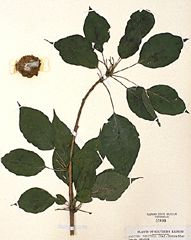Plants of Illinois

Osage Orange (Maclura pomifera)
Herbarium Collection
Illinois State Museum
Thomas Jefferson’s instructed Meriwether Lewis was to keep notes on and collect specimens of "new" plants along the route of his journey. Lewis made notes of the plants they spotted on their journey in Illinois, as they sailed down the Ohio River, up the Mississippi River, and in the vicinity of Camp Wood, where they spent the winter and spring. He made journal entries were in November, 1803, and April and May of 1804.
The Corps arrived in Illinois in the fall of 1803. The plants recorded in November were mostly trees that grew on or near the riverbanks. They included poplar, white oak, willows, cottonwood, cedar, yellow pine, spicewood (linden), and mistletoe that grew on oaks, elms, and poplars. Lewis called the yellow pine “pitchpine” and would have been interested in finding the latter species along the route of the western journey to provide pitch to cover his collapsible canoe.
Lewis was most interested in plants new to (European) science, and plants that had medicinal properties or other commercial uses (e.g., dyes, building materials). He was also looking for crops, such as turnips and “pitattoes,” that his crew could eat over their winter stay at Camp Wood, and along the Missouri River in the West. He was also planning ahead for the Euro-American settlement of the western territories.
After their arrival in Camp Wood, no plants were mentioned in the journals until April. Then the forests and fields burst with the colors of spring blossoms. On April 1, 1804, Lewis mentioned white violets, may apples, and peach, plum, and cherry blossoms. On April 10, he wrote a long description of the Osage orange, which Auguste Chouteau had brought to St. Louis from the west. Lewis also took some cuttings and sent them back to Jefferson; in 1807, he collected seeds from Chouteau's plants. Some of these seeds were planted on the University of Virginia campus at Charlottesville, where they and their descendants grow today. The Osage oranges (second photograph down on the right)at St. Peter's Church in Philadelphia may also be from those starts. He also mentioned the sandhill plums and weeping willows. By mid-April, the violets, crane’s bills, cowslips, gooseberries, and lilacs were blooming.
In May, Lewis wrote about the wild strawberry, red currants, and mulberries. He mentioned the wild potato, lotus, and white water lily roots. Roots would later be an important food source for his crew as they traveled and traded among the plains and mountain tribes.
Link to Photo Gallery, where you can read the journal entry by Meriwether Lewis for each sample image on the Museum's Herbarium sheets and photographs.